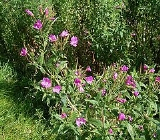
Epilobium
Encyclopedia
Epilobium is a genus
in the family
Onagraceae
, containing about 160-200 species
of flowering plant
s with a worldwide distribution. They are generally abundant in the subarctic
, temperate
and subantarctic
regions, whereas in the subtropics
and tropics
they are restricted to the cool montane
biome
s, such as the New Guinea Highlands
where they are plentiful.
The taxonomy
of the genus has varied between different botanists, but the modern trend is to include the previously recognised genera Boisduvalia, Chamaenerion, Chamerion, Pyrogennema and Zauschneria within Epilobium. Chamerion might be distinct however, as advocated for example by Peter H. Raven
who has extensively studied the willowherbs and does on the other hand merge the other segregate
genera into Epilobium. Fringed Willowherb (E. ciliatum) is suspected to be a cryptic species complex
; apparently these plants also commonly hybridize with their congeners.
Most species are known by the common name willowherbs; in particular those that were once separated in Boisduvalia are called spike-primroses or boisduvalias. Yet other species, namely ones that are placed in the Chamerion group, are also known as "fireweeds
".
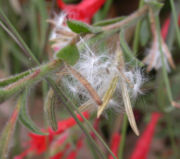 They are mostly herbaceous
They are mostly herbaceous
plants, either annual
or perennial; a few are subshrub
s. The leaves
are mostly opposite or whorled, alternate in a few species, simple, and ovate to lanceolate in shape. The flower
s have four petals. These are usually smallish and pink in most species, but red, orange or yellow in a few, and large and bright magenta
in the Chamerion group. The fruit
is a slender cylindrical capsule
containing numerous seed
s embedded in fine, soft silky fluff which disperses the seeds very effectively in the wind.
Willowherbs are typically very quick to carpet large swathes of ground and may form key or even dominant species of local ecosystem
. In and around the United Kingdom
for example, Rosebay Willowherb (E. angustifolium) is widely found in mesotrophic grassland dominated by False Oat-grass (Arrhenatherum elatius), Cock's-foot (Dactylis glomerata) and Red Festuce (Festuca rubra), while Great Willowherb (Epilobium hirsutum) is found in mesotrophic grassland with abundant False Oat-grass, Cock's-foot and Stinging Nettle
(Urtica dioica). These two willowherb species are also seen to dominate open habitat early in ecological succession
, to the virtual exclusion of other plant life. Broad-leaved Willowherb (Epilobium montanum) is found characteristically though not abundantly in the mesotrophic grasslands rich in False Oat-grass, Meadowsweet
(Filipendula ulmaria), and sometimes the otherwise rare Greek Valerian (Polemonium caeruleum), which are peculiar to the Pennines
. Most willowherbs will not tolerate shade trees well and thus are limited to comparatively freshly disturbed patches, yielding to other plants as the years pass by. Consequently, though the genus contains many pioneer plants, rather few of them are invasive weeds of major importance.
Epilobium species are used as food plants by the caterpillar
s of certain Lepidoptera
species, including:
Geometridae
Noctuidae
Sphingidae
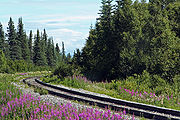 Many of the small willowherb species are nuisance weed
Many of the small willowherb species are nuisance weed
s in garden
s. Though few are regularly used as ornamental plant
s, most people find the larger willowherbs to give a pleasing aspect to ruderal locales. One of the most frequently recognized members of the genus is the circumboreal
Fireweed
(E. angustifolium), known as Rosebay Willowherb in the United Kingdom
. It rapidly colonizes burnt ground; during the bombing of London in World War II
many of the derelict bomb sites were soon covered with these plants, bringing a splash of colour to what was otherwise a very grim scene. Epilobium angustifolium is the floral emblem
of Yukon
territory in Canada
, Hedmark
county in Norway
(where the plant is called geitrams) and of the Southern Ostrobothnia
region of Finland
.
Fireweed is used as a sweetener in northwestern North America
; it is put in candies, jellies
ice cream
, syrup
and other treats, as well as in sxusem ("Indian ice-cream"). In the latter months of summer its flowers yield pollen
and copious nectar which gives a rich spicy honey
. Its young leaves, roots and shoots are edible (if somewhat bitter) and rich in provitamin A and vitamin C
; the Dena’ina
found them also useful as food supplement to keep their dogs healthy and credit the sap of the species' stem, applied to wounds, with antiinflammatory properties. Small-flowered Willowherb (E. parviflorum
) is held to improve urogenital functions in Europe
an folk medicine
Several eminent scientists have done research on these plants: Heinrich Carl Haussknecht
in the late 19th century and Peter H. Raven
about a century later have researched phylogeny, systematics
and taxonomy
of willowherbs extensively. Peter Michaelis
' studies of this genus paved the way for understanding of extranuclear inheritance
in plants.
recognizes an intermediate number of about 175 species
in 10 section
s, including two sections of Chamerion which they consider distinct. Other sources may list one or two dozen species more or less:

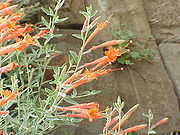 Section Boisduvalia
Section Boisduvalia
– Denseflower Willowherb, Dense Spike-primrose, Dense Boisduvalia Epilobium pallidum
– Largeflower Spike-primrose Epilobium pygmaeum
– Pygmy Willowherb, Smooth Boisduvalia Epilobium subdentatum (Meyen) Lievens & Hoch
Epilobium torreyi
– Torrey's Willowherb, Brook Spike-primrose
Section Cordylophorum
Section Crossostigma
– Leafy Willowherb, California Willowherb Epilobium minutum
– Chaparral Willowherb, Desert Willowherb, "smallflower willowherb"
Section Epilobiopsis
Section Macrocarpa
– Stiff Willowherb, Siskiyou Mountains Willowherb
Section Xerolobium
Section Zauschneria
Epilobium septentrionale
– Northern Willowherb, Humboldt County Fuchsia
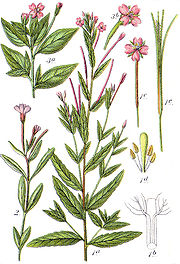
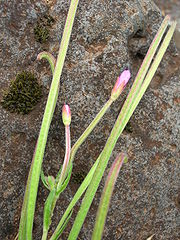
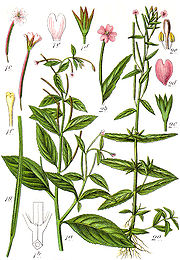
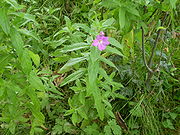 Section Epilobium
Section Epilobium
, Rosebay Willowherb; yanagiran (Japanese) Epilobium conspersum
Epilobium latifolium – Dwarf Fireweed, River Beauty Willowherb
Epilobium speciosum
Section Rosmarinifolium
Genus
In biology, a genus is a low-level taxonomic rank used in the biological classification of living and fossil organisms, which is an example of definition by genus and differentia...
in the family
Family (biology)
In biological classification, family is* a taxonomic rank. Other well-known ranks are life, domain, kingdom, phylum, class, order, genus, and species, with family fitting between order and genus. As for the other well-known ranks, there is the option of an immediately lower rank, indicated by the...
Onagraceae
Onagraceae
Onagraceae, also known as the Willowherb family or Evening Primrose family, are a family of flowering plants. The family includes about 640-650 species of herbs, shrubs, and trees in 20-24 genera...
, containing about 160-200 species
Species
In biology, a species is one of the basic units of biological classification and a taxonomic rank. A species is often defined as a group of organisms capable of interbreeding and producing fertile offspring. While in many cases this definition is adequate, more precise or differing measures are...
of flowering plant
Flowering plant
The flowering plants , also known as Angiospermae or Magnoliophyta, are the most diverse group of land plants. Angiosperms are seed-producing plants like the gymnosperms and can be distinguished from the gymnosperms by a series of synapomorphies...
s with a worldwide distribution. They are generally abundant in the subarctic
Subarctic
The Subarctic is a region in the Northern Hemisphere immediately south of the true Arctic and covering much of Alaska, Canada, the north of Scandinavia, Siberia, and northern Mongolia...
, temperate
Temperate
In geography, temperate or tepid latitudes of the globe lie between the tropics and the polar circles. The changes in these regions between summer and winter are generally relatively moderate, rather than extreme hot or cold...
and subantarctic
Subantarctic
The Subantarctic is a region in the southern hemisphere, located immediately north of the Antarctic region. This translates roughly to a latitude of between 46° – 60° south of the Equator. The subantarctic region includes many islands in the southern parts of the Indian Ocean, Atlantic Ocean and...
regions, whereas in the subtropics
Subtropics
The subtropics are the geographical and climatical zone of the Earth immediately north and south of the tropical zone, which is bounded by the Tropic of Cancer and the Tropic of Capricorn, at latitudes 23.5°N and 23.5°S...
and tropics
Tropics
The tropics is a region of the Earth surrounding the Equator. It is limited in latitude by the Tropic of Cancer in the northern hemisphere at approximately N and the Tropic of Capricorn in the southern hemisphere at S; these latitudes correspond to the axial tilt of the Earth...
they are restricted to the cool montane
Montane
In biogeography, montane is the highland area located below the subalpine zone. Montane regions generally have cooler temperatures and often have higher rainfall than the adjacent lowland regions, and are frequently home to distinct communities of plants and animals.The term "montane" means "of the...
biome
Biome
Biomes are climatically and geographically defined as similar climatic conditions on the Earth, such as communities of plants, animals, and soil organisms, and are often referred to as ecosystems. Some parts of the earth have more or less the same kind of abiotic and biotic factors spread over a...
s, such as the New Guinea Highlands
New Guinea Highlands
The New Guinea Highlands, also known as the Central Range or Central Cordillera, are a chain of mountain ranges and intermountain river valleys, many of which support thriving agricultural communities, on the large island of New Guinea, which lies to the north of Australia...
where they are plentiful.
The taxonomy
Taxonomy
Taxonomy is the science of identifying and naming species, and arranging them into a classification. The field of taxonomy, sometimes referred to as "biological taxonomy", revolves around the description and use of taxonomic units, known as taxa...
of the genus has varied between different botanists, but the modern trend is to include the previously recognised genera Boisduvalia, Chamaenerion, Chamerion, Pyrogennema and Zauschneria within Epilobium. Chamerion might be distinct however, as advocated for example by Peter H. Raven
Peter H. Raven
Peter Hamilton Raven is a botanist and environmentalist, notable as the longtime director, now President Emeritus, of the Missouri Botanical Garden.-Early life:...
who has extensively studied the willowherbs and does on the other hand merge the other segregate
Segregate (taxonomy)
In taxonomy, a segregate, or a segregate taxon is created when a taxon is split off, from another taxon. This other taxon will be better known, usually bigger, and will continue to exist, even after the segregate taxon has been split off...
genera into Epilobium. Fringed Willowherb (E. ciliatum) is suspected to be a cryptic species complex
Cryptic species complex
In biology, a cryptic species complex is a group of species which satisfy the biological definition of species—that is, they are reproductively isolated from each other—but whose morphology is very similar ....
; apparently these plants also commonly hybridize with their congeners.
Most species are known by the common name willowherbs; in particular those that were once separated in Boisduvalia are called spike-primroses or boisduvalias. Yet other species, namely ones that are placed in the Chamerion group, are also known as "fireweeds
Fireweed (disambiguation)
Fireweed is a perennial herbaceous plant in the willowherb family .Fireweed may also refer to:* Some other species of willowherb...
".
Description and ecology

Herbaceous
A herbaceous plant is a plant that has leaves and stems that die down at the end of the growing season to the soil level. They have no persistent woody stem above ground...
plants, either annual
Annual plant
An annual plant is a plant that usually germinates, flowers, and dies in a year or season. True annuals will only live longer than a year if they are prevented from setting seed...
or perennial; a few are subshrub
Subshrub
A subshrub or dwarf shrub is a short woody plant. Prostrate shrub is a similar term.It is distinguished from a shrub by its ground-hugging stems and lower height, with overwintering perennial woody growth typically less than 10–20 cm tall, or by being only weakly woody and/or persisting...
s. The leaves
Leaf
A leaf is an organ of a vascular plant, as defined in botanical terms, and in particular in plant morphology. Foliage is a mass noun that refers to leaves as a feature of plants....
are mostly opposite or whorled, alternate in a few species, simple, and ovate to lanceolate in shape. The flower
Flower
A flower, sometimes known as a bloom or blossom, is the reproductive structure found in flowering plants . The biological function of a flower is to effect reproduction, usually by providing a mechanism for the union of sperm with eggs...
s have four petals. These are usually smallish and pink in most species, but red, orange or yellow in a few, and large and bright magenta
Magenta
Magenta is a color evoked by light stronger in blue and red wavelengths than in yellowish-green wavelengths . In light experiments, magenta can be produced by removing the lime-green wavelengths from white light...
in the Chamerion group. The fruit
Fruit
In broad terms, a fruit is a structure of a plant that contains its seeds.The term has different meanings dependent on context. In non-technical usage, such as food preparation, fruit normally means the fleshy seed-associated structures of certain plants that are sweet and edible in the raw state,...
is a slender cylindrical capsule
Capsule (fruit)
In botany a capsule is a type of simple, dry fruit produced by many species of flowering plants. A capsule is a structure composed of two or more carpels that in most cases is dehiscent, i.e. at maturity, it splits apart to release the seeds within. A few capsules are indehiscent, for example...
containing numerous seed
Seed
A seed is a small embryonic plant enclosed in a covering called the seed coat, usually with some stored food. It is the product of the ripened ovule of gymnosperm and angiosperm plants which occurs after fertilization and some growth within the mother plant...
s embedded in fine, soft silky fluff which disperses the seeds very effectively in the wind.
Willowherbs are typically very quick to carpet large swathes of ground and may form key or even dominant species of local ecosystem
Ecosystem
An ecosystem is a biological environment consisting of all the organisms living in a particular area, as well as all the nonliving , physical components of the environment with which the organisms interact, such as air, soil, water and sunlight....
. In and around the United Kingdom
United Kingdom
The United Kingdom of Great Britain and Northern IrelandIn the United Kingdom and Dependencies, other languages have been officially recognised as legitimate autochthonous languages under the European Charter for Regional or Minority Languages...
for example, Rosebay Willowherb (E. angustifolium) is widely found in mesotrophic grassland dominated by False Oat-grass (Arrhenatherum elatius), Cock's-foot (Dactylis glomerata) and Red Festuce (Festuca rubra), while Great Willowherb (Epilobium hirsutum) is found in mesotrophic grassland with abundant False Oat-grass, Cock's-foot and Stinging Nettle
Stinging nettle
Stinging nettle or common nettle, Urtica dioica, is a herbaceous perennial flowering plant, native to Europe, Asia, northern Africa, and North America, and is the best-known member of the nettle genus Urtica...
(Urtica dioica). These two willowherb species are also seen to dominate open habitat early in ecological succession
Ecological succession
Ecological succession, is the phenomenon or process by which a community progressively transforms itself until a stable community is formed. It is a fundamental concept in ecology, and refers to more or less predictable and orderly changes in the composition or structure of an ecological community...
, to the virtual exclusion of other plant life. Broad-leaved Willowherb (Epilobium montanum) is found characteristically though not abundantly in the mesotrophic grasslands rich in False Oat-grass, Meadowsweet
Meadowsweet
Filipendula ulmaria, commonly known as Meadowsweet, is a perennial herb in the family Rosaceae that grows in damp meadows. It is native throughout most of Europe and Western Asia...
(Filipendula ulmaria), and sometimes the otherwise rare Greek Valerian (Polemonium caeruleum), which are peculiar to the Pennines
Pennines
The Pennines are a low-rising mountain range, separating the North West of England from Yorkshire and the North East.Often described as the "backbone of England", they form a more-or-less continuous range stretching from the Peak District in Derbyshire, around the northern and eastern edges of...
. Most willowherbs will not tolerate shade trees well and thus are limited to comparatively freshly disturbed patches, yielding to other plants as the years pass by. Consequently, though the genus contains many pioneer plants, rather few of them are invasive weeds of major importance.
Epilobium species are used as food plants by the caterpillar
Caterpillar
Caterpillars are the larval form of members of the order Lepidoptera . They are mostly herbivorous in food habit, although some species are insectivorous. Caterpillars are voracious feeders and many of them are considered to be pests in agriculture...
s of certain Lepidoptera
Lepidoptera
Lepidoptera is a large order of insects that includes moths and butterflies . It is one of the most widespread and widely recognizable insect orders in the world, encompassing moths and the three superfamilies of butterflies, skipper butterflies, and moth-butterflies...
species, including:
Geometridae
- Grey PugGrey PugThe Grey Pug is a moth of the family Geometridae. It is found throughout the Palearctic region and the Near East.The forewings of this species are grey marked with pale fascia and radial lines which give it a mottled appearance. The hindwings are much paler and plainer. Melanism is quite common in...
(Eupithecia subfuscata), recorded on several species - Double-striped PugDouble-striped PugThe Double-striped Pug is a moth of the family Geometridae. It is a widespread and common species, being found throughout the Palearctic region, the Near East and North Africa....
(Gymnoscelis rufifasciata), recorded on FireweedFireweedEpilobium angustifolium, commonly known as Fireweed , Great Willow-herb , or Rosebay Willowherb , is a perennial herbaceous plant in the willowherb family Onagraceae...
(E. angustifolium)
Noctuidae
Noctuidae
The Noctuidae or owlet moths are a family of robustly-built moths that includes more than 35,000 known species out of possibly 100,000 total, in more than 4,200 genera. They constitute the largest family in the Lepidoptera....
- Mouse MothMouse MothThe Mouse Moth is a moth of the family Noctuidae. It is a very widespread species with a Holarctic distribution.This is a rather drab but distinctive species. The forewings are uniform dark brown with three blackish spots arranged in a triangle. The hindwings are buffish, darker towards the...
(Amphipyra tragopoginis), recorded on several species - Small Angle ShadesSmall Angle ShadesThe small angle shades is a moth of the family Noctuidae. It is distributed throughout Europe.As the common name suggests, this species is closely related to the angle shades , and is considerably smaller , but does not especially resemble that species...
(Euplexia lucipara), recorded on several species - The GothicGothic (moth)The Gothic is a moth of the family Noctuidae. It is distributed in temperate Eurasia.This species has a wingspan of 36–46 mm. The forewings are broader than most other noctuids, blackish with a network of fine white lines . The hindwings are grey. The species flies at night in June and July...
(Naenia typica), recorded on FireweedFireweedEpilobium angustifolium, commonly known as Fireweed , Great Willow-herb , or Rosebay Willowherb , is a perennial herbaceous plant in the willowherb family Onagraceae...
(E. angustifolium) - Hebrew CharacterHebrew CharacterHebrew Character is a moth species, Orthosia gothica, of the family Noctuidae. It is found throughout Europe.The forewings of this species are greyish to rufous brown. Typically these are marked with a black mark shaped like the Hebrew letter Nun נ). This is similar to the markings of the Setaceous...
(Orthosia gothica), recorded on FireweedFireweedEpilobium angustifolium, commonly known as Fireweed , Great Willow-herb , or Rosebay Willowherb , is a perennial herbaceous plant in the willowherb family Onagraceae...
(E. angustifolium) - Australian Grapevine Moth (Phalaenoides glycinae), recorded on Fringed Willowherb (E. ciliatum)
- Setaceous Hebrew CharacterSetaceous Hebrew CharacterThe Setaceous Hebrew Character is a moth of the family Noctuidae. It is found in the Palearctic ecozone. It is a common species throughout Europe. It is also found in North America, from coast to coast across Canada and the northern United States to western Alaska. It occurs in the Rocky Mountains...
(Xestia c-nigrum), recorded on FireweedFireweedEpilobium angustifolium, commonly known as Fireweed , Great Willow-herb , or Rosebay Willowherb , is a perennial herbaceous plant in the willowherb family Onagraceae...
(E. angustifolium)
Sphingidae
Sphingidae
Sphingidae is a family of moths , commonly known as hawk moths, sphinx moths and hornworms, that includes about 1,200 species . It is best represented in the tropics but there are species in every region . They are moderate to large in size and are distinguished among moths for their rapid,...
- Elephant Hawk-moth (Deilephila elpenor), recorded on several species
- Small Elephant Hawk-moth (Deilephila porcellus), recorded on several species
- White-lined Sphinx (Hyles lineata), recorded on several species
Use by humans

Weed
A weed in a general sense is a plant that is considered by the user of the term to be a nuisance, and normally applied to unwanted plants in human-controlled settings, especially farm fields and gardens, but also lawns, parks, woods, and other areas. More specifically, the term is often used to...
s in garden
Garden
A garden is a planned space, usually outdoors, set aside for the display, cultivation, and enjoyment of plants and other forms of nature. The garden can incorporate both natural and man-made materials. The most common form today is known as a residential garden, but the term garden has...
s. Though few are regularly used as ornamental plant
Ornamental plant
Ornamental plants are plants that are grown for decorative purposes in gardens and landscape design projects, as house plants, for cut flowers and specimen display...
s, most people find the larger willowherbs to give a pleasing aspect to ruderal locales. One of the most frequently recognized members of the genus is the circumboreal
Circumboreal Region
The Circumboreal Region is a floristic region within the Holarctic Kingdom in Eurasia and North America, as delineated by such geobotanists as Josias Braun-Blanquet and Armen Takhtajan....
Fireweed
Fireweed
Epilobium angustifolium, commonly known as Fireweed , Great Willow-herb , or Rosebay Willowherb , is a perennial herbaceous plant in the willowherb family Onagraceae...
(E. angustifolium), known as Rosebay Willowherb in the United Kingdom
United Kingdom
The United Kingdom of Great Britain and Northern IrelandIn the United Kingdom and Dependencies, other languages have been officially recognised as legitimate autochthonous languages under the European Charter for Regional or Minority Languages...
. It rapidly colonizes burnt ground; during the bombing of London in World War II
World War II
World War II, or the Second World War , was a global conflict lasting from 1939 to 1945, involving most of the world's nations—including all of the great powers—eventually forming two opposing military alliances: the Allies and the Axis...
many of the derelict bomb sites were soon covered with these plants, bringing a splash of colour to what was otherwise a very grim scene. Epilobium angustifolium is the floral emblem
Floral emblem
In a number of countries, plants have been chosen as symbols to represent specific geographic areas. Some countries have a country-wide floral emblem; others in addition have symbols representing subdivisions. Different processes have been used to adopt these symbols - some are conferred by...
of Yukon
Yukon
Yukon is the westernmost and smallest of Canada's three federal territories. It was named after the Yukon River. The word Yukon means "Great River" in Gwich’in....
territory in Canada
Canada
Canada is a North American country consisting of ten provinces and three territories. Located in the northern part of the continent, it extends from the Atlantic Ocean in the east to the Pacific Ocean in the west, and northward into the Arctic Ocean...
, Hedmark
Hedmark
is a county in Norway, bordering Sør-Trøndelag, Oppland and Akershus. The county administration is in Hamar.Hedmark makes up the northeastern part of Østlandet, the southeastern part of the country. It includes a long part of the borderline with Sweden, Dalarna County and Värmland County. The...
county in Norway
Norway
Norway , officially the Kingdom of Norway, is a Nordic unitary constitutional monarchy whose territory comprises the western portion of the Scandinavian Peninsula, Jan Mayen, and the Arctic archipelago of Svalbard and Bouvet Island. Norway has a total area of and a population of about 4.9 million...
(where the plant is called geitrams) and of the Southern Ostrobothnia
Southern Ostrobothnia
Southern Ostrobothnia is one of the 20 regions of Finland.Seinäjoki is the regional centre and by far the largest city in the area.- Historical provinces :For History, Geography and Culture see: Ostrobothnia- Municipalities :...
region of Finland
Finland
Finland , officially the Republic of Finland, is a Nordic country situated in the Fennoscandian region of Northern Europe. It is bordered by Sweden in the west, Norway in the north and Russia in the east, while Estonia lies to its south across the Gulf of Finland.Around 5.4 million people reside...
.
Fireweed is used as a sweetener in northwestern North America
North America
North America is a continent wholly within the Northern Hemisphere and almost wholly within the Western Hemisphere. It is also considered a northern subcontinent of the Americas...
; it is put in candies, jellies
Fruit preserves
Fruit preserves are preparations of fruits and sugar, often canned or sealed for long-term storage. The preparation of fruit preserves today often involves adding commercial or natural pectin as a gelling agent, although sugar or honey may be used, as well. Prior to World War II, fruit preserve...
ice cream
Ice cream
Ice cream is a frozen dessert usually made from dairy products, such as milk and cream, and often combined with fruits or other ingredients and flavours. Most varieties contain sugar, although some are made with other sweeteners...
, syrup
Syrup
In cooking, a syrup is a thick, viscous liquid consisting primarily of a solution of sugar in water, containing a large amount of dissolved sugars but showing little tendency to deposit crystals...
and other treats, as well as in sxusem ("Indian ice-cream"). In the latter months of summer its flowers yield pollen
Pollen
Pollen is a fine to coarse powder containing the microgametophytes of seed plants, which produce the male gametes . Pollen grains have a hard coat that protects the sperm cells during the process of their movement from the stamens to the pistil of flowering plants or from the male cone to the...
and copious nectar which gives a rich spicy honey
Honey
Honey is a sweet food made by bees using nectar from flowers. The variety produced by honey bees is the one most commonly referred to and is the type of honey collected by beekeepers and consumed by humans...
. Its young leaves, roots and shoots are edible (if somewhat bitter) and rich in provitamin A and vitamin C
Vitamin C
Vitamin C or L-ascorbic acid or L-ascorbate is an essential nutrient for humans and certain other animal species. In living organisms ascorbate acts as an antioxidant by protecting the body against oxidative stress...
; the Dena’ina
Dena’ina
The Dena'ina are an Alaska Native people, an extended tribe of American Indian lineage. They are the original inhabitants of the southcentral Alaska region ranging from Seldovia in the south to Chickaloon in the northeast, Talkeetna in the north, Lime Village in the Northwest and Pedro Bay in the...
found them also useful as food supplement to keep their dogs healthy and credit the sap of the species' stem, applied to wounds, with antiinflammatory properties. Small-flowered Willowherb (E. parviflorum
Epilobium parviflorum
Epilobium parviflorum, commonly known as Smallflower Hairy Willowherb, is a herbaceous perennial plant belonging to the Onagraceae family.-Etymology:...
) is held to improve urogenital functions in Europe
Europe
Europe is, by convention, one of the world's seven continents. Comprising the westernmost peninsula of Eurasia, Europe is generally 'divided' from Asia to its east by the watershed divides of the Ural and Caucasus Mountains, the Ural River, the Caspian and Black Seas, and the waterways connecting...
an folk medicine
Folk medicine
-Description:Refers to healing practices and ideas of body physiology and health preservation known to a limited segment of the population in a culture, transmitted informally as general knowledge, and practiced or applied by anyone in the culture having prior experience.All cultures and societies...
Several eminent scientists have done research on these plants: Heinrich Carl Haussknecht
Heinrich Carl Haussknecht
Heinrich Carl Haussknecht was a German pharmacist and botanical collector who was a native of Bennungen, Sachsen-Anhalt.Trained as a pharmacist, Haussknecht is remembered for his extensive collection and description of plant species...
in the late 19th century and Peter H. Raven
Peter H. Raven
Peter Hamilton Raven is a botanist and environmentalist, notable as the longtime director, now President Emeritus, of the Missouri Botanical Garden.-Early life:...
about a century later have researched phylogeny, systematics
Systematics
Biological systematics is the study of the diversification of terrestrial life, both past and present, and the relationships among living things through time. Relationships are visualized as evolutionary trees...
and taxonomy
Taxonomy
Taxonomy is the science of identifying and naming species, and arranging them into a classification. The field of taxonomy, sometimes referred to as "biological taxonomy", revolves around the description and use of taxonomic units, known as taxa...
of willowherbs extensively. Peter Michaelis
Peter Michaelis
Peter Michaelis was a German plant geneticist who focused most of his research on cytoplasm inheritance and segregation. Most of Michaelis work was carried out during the period from 1940's to 1970's at the Max Planck Institute for Plant Breeding Research in Köln/Vogelsang.- Research :Michaelis...
' studies of this genus paved the way for understanding of extranuclear inheritance
Extranuclear Inheritance
Extranuclear inheritance is the transmission of genes that occur outside the nucleus. It is found in most eukaryotes and is commonly known to occur in cytoplasmic organelles such as mitochondria and chloroplasts or from cellular parasites like viruses or bacteria .- Extranuclear Inheritance of...
in plants.
Species
The National Museum of Natural HistoryNational Museum of Natural History
The National Museum of Natural History is a natural history museum administered by the Smithsonian Institution, located on the National Mall in Washington, D.C., United States. Admission is free and the museum is open 364 days a year....
recognizes an intermediate number of about 175 species
Species
In biology, a species is one of the basic units of biological classification and a taxonomic rank. A species is often defined as a group of organisms capable of interbreeding and producing fertile offspring. While in many cases this definition is adequate, more precise or differing measures are...
in 10 section
Section (botany)
In botany, a section is a taxonomic rank below the genus, but above the species. The subgenus, if present, is higher than the section, and the rank of series, if present, is below the section. Sections are typically used to help organise very large genera, which may have hundreds of species...
s, including two sections of Chamerion which they consider distinct. Other sources may list one or two dozen species more or less:


Epilobium densiflorum
Epilobium densiflorum is a species of willowherb known by the common names Denseflower Willowherb, Dense Spike-primrose or Dense Boisduvalia. It is native to western North America from British Columbia to Baja California, where it is found in a variety of habitats. This is an erect annual often...
– Denseflower Willowherb, Dense Spike-primrose, Dense Boisduvalia
Epilobium pallidum
Epilobium pallidum is a species of flowering plant in the evening primrose family known by the common name largeflower spike-primrose. It is native to western United States, where it grows in moist areas in northern California, Oregon, and Idaho...
– Largeflower Spike-primrose
Epilobium pygmaeum
Epilobium pygmaeum is a species of willowherb known by the common names Pygmy Willowherb and Smooth Boisduvalia. This plant is native to western North America from Baja California to Saskatchewan. It is a resident of vernal pools and mudflats. This is an annual rarely reaching half a meter in height...
– Pygmy Willowherb, Smooth Boisduvalia
Epilobium torreyi
Epilobium torreyi is a species of flowering plant in the evening primrose family known by the common names Torrey's Willowherb and Brook Spike-primrose. It is native to western North America from British Columbia to California, where it grows in many types of habitat, often in moist areas...
– Torrey's Willowherb, Brook Spike-primrose
Section Cordylophorum
- Subsection Nuttalia
- Epilobium suffruticosum Nutt. ex Torr. & A.Gray – Shrubby Willowherb
- Subsection Petrolobium
- Epilobium nevadense Munz – Nevada Willowherb
- Epilobium nivium Brandegee – Snow Mountain Willowherb
Section Crossostigma
Epilobium foliosum
Epilobium foliosum is a species of flowering plant in the evening primrose family known by the common names Leafy Willowherb and California Willowherb...
– Leafy Willowherb, California Willowherb
Epilobium minutum
Epilobium minutum is a species of willowherb known by the common names Chaparral Willowherb and Desert Willowherb. It is also called "smallflower willowherb", however that name, in particular the British English variant "Small-flowered Willowherb", typically refers to Epilobium parviflorum.This...
– Chaparral Willowherb, Desert Willowherb, "smallflower willowherb"
Section Epilobiopsis
- Epilobium campestre (Jeps.) Hoch & W.L.Wagner
- Epilobium cleistogamumEpilobium cleistogamumEpilobium cleistogamum is a species of willowherb known by the common name selfing willowherb. This plant is endemic to central California where it is a resident of vernal pools and mudflats. This is a small annual with fuzzy pointed green leaves. Some of the leaves have hairs which are knobby and...
– Selfing Willowherb
Section Macrocarpa
Epilobium rigidum
Epilobium rigidum is an uncommon species of flowering plant in the evening primrose family known by the common names Stiff Willowherb and Siskiyou Mountains Willowherb....
– Stiff Willowherb, Siskiyou Mountains Willowherb
Section Xerolobium
- Epilobium brachycarpumEpilobium brachycarpumEpilobium brachycarpum is a species of willowherb known by the common names Tall Willowherb, Tall Annual Willowherb, Panicled Willowherb and Tall Fireweed. It is native to and widespread in North America, where it is a resident of varied open and woodland habitats. It has also been introduced to...
– Tall Willowherb, Tall Annual Willowherb, Tall Fireweed, Panicled Willowherb
Section Zauschneria
Epilobium septentrionale
Epilobium septentrionale, with the common names Humboldt County Fuchsia and Northern Willowherb, is a species of willowherb. Like the wildflower zauschneria, this plant was once treated as a member of genus Zauschneria but has more recently been placed with the willowherbs.-Description:Epilobium...
– Northern Willowherb, Humboldt County Fuchsia




- Epilobium aitchisonii P.H.Raven
- Epilobium algidum M.Bieb.
- Epilobium alpestre (Jacq.) Krock.
- Epilobium alsinifolium Vill. – Chickweed Willowherb
- Epilobium alsinoides A.Cunn.
- Epilobium alsinoides ssp. alsinoides
- Epilobium alsinoides ssp. atriplicifolium (A.Cunn.) P.H.Raven & Engelhorn
- Epilobium alsinoides ssp. tenuipes (Hook.f.) P.H. Raven & Engelhorn
- Epilobium amurense Hausskn.
- Epilobium amurense ssp. amurense
- Epilobium amurense ssp. cephalostigma (Hausskn.) C.J.Chen, Hoch & P.H.Raven
- Epilobium anagallidifoliumEpilobium anagallidifoliumEpilobium anagallidifolium is a species of willowherb known by the common names pimpernel willowherb and alpine willowherb. This small flowering plant has a circumboreal distribution and can be found in mountain ranges further south, where grows in alpine climates. It is a perennial found in low...
– Alpine Willowherb, Pimpernel Willowherb - Epilobium anatolicum Hausskn.
- Epilobium anatolicum ssp. anatolicum
- Epilobium anatolicum ssp. prionophyllum (Hausskn.) P.H.Raven
- Epilobium angustum (Cheeseman) P.H. Raven & Engelhorn
- Epilobium arcticum Sam. – Arctic Willowherb (sometimes included in E. davuricum)
- Epilobium astonii (Allan) P.H.Raven & Engelhorn
- Epilobium atlanticum Litard. & Maire
- Epilobium australe Poeppig & Hausskn.
- Epilobium barbeyanum H.Lév.
- Epilobium billardierianum Ser. – Glabrous Willowherb
- Epilobium billardierianum ssp. billardierianum
- Epilobium billardierianum ssp. cinereum (A.Rich.) P.H.Raven & Engelhorn
- Epilobium billardierianum ssp. hydrophilum P.H. Raven & Engelhorn
- Epilobium billardierianum ssp. intermedium P.H. Raven & Engelhorn
- Epilobium blinii H.Lév.
- Epilobium brevifolium D.Don
- Epilobium brevifolium ssp. brevifolium
- Epilobium brevifolium ssp. trichoneurum (Hausskn.) P.H.Raven
- Epilobium brevipes Hook.f.
- Epilobium brevisquamatum P.H.Raven
- Epilobium brunnescens (Cockayne) P.H. Raven & Engelhorn – New Zealand Willowherb
- Epilobium brunnescens ssp. beaugleholei K.R.West & P.H.Raven
- Epilobium brunnescens ssp. brunnescens
- Epilobium brunnescens ssp. minutiflorum (Cockayne) P.H. Raven & Engelhorn
- Epilobium capense Buchinger ex Hochst.
- Epilobium chionanthum Hausskn.
- Epilobium chitralense P.H.Raven
- Epilobium chlorifolium Hausskn.
- Epilobium ciliatumEpilobium ciliatumEpilobium ciliatum is a species of willowherb known by the common names Fringed Willowherb and American Willowherb. This plant is found in many parts of the world. It is native to much of North America and eastern Asia, and it is an introduced species in much of Eurasia and Australia...
– Fringed Willowherb, American Willowherb - Epilobium clarkeanum Hausskn.
- Epilobium clavatumEpilobium clavatumEpilobium clavatum is a species of flowering plant in the evening primrose family known by the common names Talus Willowherb and Clavatefruit Willowherb. It is native to western North America from Alaska to northern California to Colorado, where it grows in rocky high mountain habitat such as talus...
– Talus Willowherb, Clavatefruit Willowherb - Epilobium collinum C.C.Gmelin
- Epilobium coloratum Biehler – Purpleleaf Willowherb
- Epilobium confertifolium Hook.f.
- Epilobium confusum Hausskn.
- Epilobium conjungens Skottsb.
- Epilobium crassum Hook.f.
- Epilobium curtisiae P.H.Raven
- Epilobium cylindricum D.Don
- Epilobium davuricum Fisch. ex Hornem. – Daurian Willowherb
- Epilobium densifolium Hausskn.
- Epilobium denticulatum Ruiz & Pav.
- Epilobium detzneranum Schltr. ex Diels
- Epilobium duriaei Gay ex Godr.
- Epilobium fangii C.J.Chen, Hoch & P.H.Raven
- Epilobium fastigiatoramosum Nakai
- Epilobium fauriei H.Lév.
- Epilobium forbesii Allan
- Epilobium fragile Sam.
- Epilobium frigidum Hausskn.
- Epilobium fugitivum P.H. Raven & Engelhorn
- Epilobium gemmascens C.A.Mey.
- Epilobium glabellum G.Forst. – Smooth Spike-primrose
- Epilobium glaberrimumEpilobium glaberrimumEpilobium glaberrimum is a species of willowherb known by the common name glaucous willowherb. This clumping perennial wildflower is native to western North America from central Canada to northern Mexico. It generally grows at some elevation in moist places. This plant is somewhat variable in...
– Glaucous Willowherb - Epilobium glaciale P.H.Raven
- Epilobium glaucum Phil.
- Epilobium gouldii P.H.Raven
- Epilobium gracilipes Kirk
- Epilobium griffithianum Hausskn.
- Epilobium gunnianum Hausskn.
- Epilobium halleanumEpilobium halleanumEpilobium halleanum is a species of flowering plant in the evening primrose family known by the common name glandular willowherb. It is native to parts of western North America from British Columbia to New Mexico, where it grows in many types of habitat. It is an erect perennial herb growing up to...
– Glandular Willowherb - Epilobium hectorii Hausskn.
- Epilobium hirsutumEpilobium hirsutumEpilobium hirsutum is a flowering plant belonging to the willowherb genus Epilobium in the family Onagraceae. It is commonly known as the great willowherb, great hairy willowherb or hairy willowherb. Local names include codlins-and-cream, apple-pie and cherry-pie.It is a tall, perennial plant,...
– Great Willowherb, Great Hairy Willowherb, Hairy Willowherb, Codlins-and-cream, Apple-pie, "cherry-pieCherry pie (disambiguation)A cherry pie is a pie made with cherry filling. The term may also refer to:* Cherry Pie , an album by glam metal band Warrant** "Cherry Pie ", a song from the album of the same name...
" - Epilobium hirtigerum A.Cunn.
- Epilobium hohuanense S.S.Ying
- Epilobium hooglandii P.H.Raven
- Epilobium hornemannii Rchb. – Hornemann's Willowherb
- Epilobium hornemannii ssp. behringianum (Hausskn.) Hoch & P.H.Raven
- Epilobium hornemannii ssp. hornemannii
- Epilobium howelliiEpilobium howelliiEpilobium howellii is an uncommon species of flowering plant in the evening primrose family known by the common names Yuba Pass Willowherb and Subalpine Fireweed...
– Yuba Pass Willowherb, Subalpine Fireweed - Epilobium indicum Hausskn.
- Epilobium insulare Hausskn.
- Epilobium kermodei P.H.Raven
- Epilobium keysseri Diels
- Epilobium kingdonii P.H.Raven
- Epilobium komarovianum H.Lév. – Bronzy Willowherb
- Epilobium lactiflorumEpilobium lactiflorumEpilobium lactiflorum is a species of willowherb known by the common name Milkflower Willowherb or Whiteflower Willowherb. This plant is found throughout northern North America and northern Eurasia, where it most often grows in moist, rocky areas at some elevation...
– Milkflower Willowherb, Whiteflower Willowherb - Epilobium lanceolatum Sebast. & Mauri – Spear-leaved Willowherb
- Epilobium laxum Royle
- Epilobium leiophyllum Hausskn.
- Epilobium leptocarpum Hausskn. – Slenderfruit Willowherb
- Epilobium leptophyllumEpilobium leptophyllumEpilobium leptophyllum is a species of flowering plant in the evening primrose family known by the common names Bog Willowherb and Linear-leaved Willowherb. It is native to much of eastern and northern North America, where it grows in moist areas, such as bogs. It is a perennial herb growing up to...
– Bog Willowherb, Linear-leaved Willowherb - Epilobium luteum Pursh – Yellow Willowherb
- Epilobium macropus Hook.
- Epilobium margaretiae Brockie
- Epilobium matthewsii Petrie
- Epilobium maysillesii Munz
- Epilobium melanocaulon Hook.
- Epilobium microphyllum A.Rich.
- Epilobium minutiflorum Hausskn.
- Epilobium mirabile Trel. – Olympic Mountain Willowherb
- Epilobium montanumEpilobium montanumEpilobium montanum or Broad-leaved Willowherb is a species of willowherb....
– Broad-leaved Willowherb - Epilobium nankotaizanense Yamam. – Nankotaizan Willowherb
- Epilobium nerteroides A.Cunn.
- Epilobium nivale Meyen
- Epilobium nummulariifolium R.Cunn. ex A.Cunn.
- Epilobium nutans F.W.Schmidt
- Epilobium obcordatumEpilobium obcordatumEpilobium obcordatum is a species of willowherb known by the common name Rockfringe Willowherb. It is native to the western United States from California to Idaho, where it is found in rocky mountainous areas. This small perennial is clumpy to mat-forming and spreads from a woody caudex, especially...
– Rockfringe Willowherb - Epilobium obscurum Schreb. – Dwarf Willowherb, Short-fruited Willowherb
- Epilobium oreganumEpilobium oreganumEpilobium oreganum is an uncommon species of flowering plant in the evening primrose family known by the common name Grants Pass Willowherb and Oregon Fireweed . It is native to southern Oregon and northern California, where it is historically known mostly from the Klamath Mountains...
– Grants Pass Willowherb, Oregon Fireweed - Epilobium oregonenseEpilobium oregonenseEpilobium oregonense is a species of flowering plant in the evening primrose family known by the common name Oregon Willowherb. It is native to western North America from British Columbia to Arizona, where it generally grows in moist places in several types of habitat...
– Oregon Willowherb - Epilobium pallidiflorum Sol. ex A.Cunn.
- Epilobium palustreEpilobium palustreEpilobium palustre is a species of willowherb known by the common name marsh willowherb. This plant has a circumboreal distribution, and can be found farther south in mountainous areas. This is a hairy perennial growing spindly stems sometimes exceeding half a meter in height. Its stems have...
– Marsh Willowherb - Epilobium pannosum Hausskn.
- Epilobium parviflorumEpilobium parviflorumEpilobium parviflorum, commonly known as Smallflower Hairy Willowherb, is a herbaceous perennial plant belonging to the Onagraceae family.-Etymology:...
Schreb. – Small-flowered Willowherb, Hoary Willowherb - Epilobium pedicellare C.Presl
- Epilobium pedunculare A.Cunn. – Rockery Willowherb
- Epilobium pengii C.J.Chen, Hoch & P.H.Raven
- Epilobium pernitens Cockayne & Allan
- Epilobium perpusillum Hausskn.
- Epilobium petraeum Heenan
- Epilobium pictum Petrie
- Epilobium platystigmatosum C.B.Rob.
- Epilobium ponticum Hausskn.
- Epilobium porphyrium G.Simpson
- Epilobium prostratum Warb.
- Epilobium psilotum Maire & Sam.
- Epilobium pubens A.Rich.
- Epilobium puberulum Hook. & Arn.
- Epilobium purpuratum Hook.f.
- Epilobium pycnostachyum Hausskn.
- Epilobium pyrricholophum Franch. & Sav.
- Epilobium rechingeri P.H.Raven
- Epilobium rhynchospermum Boiss.
- Epilobium roseum Schreb. – Pale Willowherb
- Epilobium roseum ssp. consimile (Hausskn.) P.H.Raven
- Epilobium roseum ssp. roseum
- Epilobium roseum ssp. subsessile (Boiss.) P.H.Raven
- Epilobium rostratum Cheeseman
- Epilobium rotundifolium G.Forst.
- Epilobium royleanum Hausskn.
- Epilobium rupicolum Pavlov
- Epilobium salignum Hausskn.
- Epilobium sarmentaceum Hausskn.
- Epilobium saximontanum Hausskn. – Rocky Mountain Willowherb
- Epilobium sikkimense Hausskn.
- Epilobium sinense H.Lév.
- Epilobium siskiyouenseEpilobium siskiyouenseEpilobium siskiyouense is a rare species of flowering plant in the evening primrose family known by the common names Siskiyou Willowherb and Siskiyou Fireweed ....
– Siskiyou Willowherb, Siskiyou Fireweed - Epilobium smithii H.Lév.
- Epilobium staintonii P.H.Raven
- Epilobium stereophyllum Fresen.
- Epilobium stracheyanum Hausskn.
- Epilobium strictum Muhl. – Downy Willowherb, Stiff Spike-primrose
- Epilobium subalgidum Hausskn.
- Epilobium subcoriaceum Hausskn.
- Epilobium subnivale Popov ex Pavlov
- Epilobium taiwanianum C.J.Chen, Hoch & P.H.Raven
- Epilobium tasmanicum Hausskn.
- Epilobium tetragonum L. – Square-stemmed Willowherb
- Epilobium tetragonum ssp. lamyi (F.W.Schultz) Nyman
- Epilobium tetragonum ssp. tetragonum
- Epilobium tetragonum ssp. tournefortii (Michalet) H.Lév.
- Epilobium tianschanicum Pavlov
- Epilobium tibetanum Hausskn.
- Epilobium trichophyllum Hausskn.
- Epilobium vernonicum Snogerup
- Epilobium wallichianum Hausskn.
- Epilobium warakense Nábelek
- Epilobium wattianum Hausskn.
- Epilobium williamsii P.H.Raven
- Epilobium willisii P.H. Raven & Engelhorn
- Epilobium wilsonii Cheeseman
- Epilobium × wisconsinense Ugent – Wisconsin Willowherb (= E. ciliatum ssp. ciliatum × E. coloratum)
Chamerion group
Section ChamerionFireweed
Epilobium angustifolium, commonly known as Fireweed , Great Willow-herb , or Rosebay Willowherb , is a perennial herbaceous plant in the willowherb family Onagraceae...
, Rosebay Willowherb; yanagiran (Japanese)
Section Rosmarinifolium
- Epilobium colchicum
- Epilobium dodonaei
- Epilobium fleischeriEpilobium fleischeriEpilobium fleischeri, commonly known as Alpine Willowherb, is a herbaceous perennial plant belonging to the Onagraceae family.-Description:...
- Epilobium stevenii
Formerly placed here
- Escallonia pulverulenta
- Stylidium tenellumStylidium tenellumStylidium tenellum is a dicotyledonous plant that belongs to the genus Stylidium . It is an annual plant that grows from 5 to 27 cm tall. The obovate or elliptical leaves, about 6-14 per plant, are scattered along the elongate, glabrous stem and are generally 3.5-8.5 mm long and...
(as E. tonkinense)

